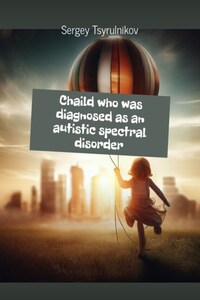© Sergey Tsyrulnikov, 2023
ISBN 978-5-0060-0384-2
Created with Ridero smart publishing system
This book is a must-read for anyone who wants to gain a better understanding of Autism Spectrum Disorder (ASD). It covers a range of topics across seven chapters, providing valuable insights, practical advice, and support for individuals with ASD and their families.
Chapter 1: Understanding Autism Spectrum Disorders (ASD)
Autism spectrum disorder (ASD) is a complex disorder of the nervous system that affects an individual's ability to communicate, socialise and interact with the world around them. It is important to note that RAS is a broad spectrum, manifesting in each individual in a unique way, with varying degrees of severity.
Children with ASD typically show signs of the disorder in early childhood, before the age of three. These signs include difficulties in social interaction, difficulty with eye contact, using gestures, and understanding social cues. In addition, children with RAS may exhibit repetitive behaviour, have limited interests and have difficulty adapting to change.
1.2 Types of ASD and how they are diagnosed
There are several types of ASD such as autistic disorder, Asperger’s syndrome and pervasive developmental disorder not otherwise specified (PDD-NOS). Diagnosis of ASD is based on a careful assessment by a team of specialists including a paediatrician, neurologist, psychologist and speech and language pathologist.
The assessment process includes a physical examination to rule out other possible causes of symptoms, behavioural observations, interviews with parents and an assessment of the child's language, communication and cognitive skills. A more complex assessment is required when RAS is suspected.
1.3 Causes and risk factors for ASD
The exact causes of ASD are not yet fully understood, but researchers believe that a combination of genetic and environmental factors may contribute to the development of the disorder. Some of the known risk factors for ASD include:
Genetic factors: ASD tends to run in families, and certain genetic mutations may increase the risk of developing the disorder.
Environmental factors: exposure to certain toxins or chemicals during pregnancy, complications during pregnancy or childbirth, and intrauterine infections can increase the risk of ASD.
Brain development: abnormalities in brain development or function may play a role in the development of ASD.
Although the causes of ASD are not fully understood, researchers continue to study the disorder in hopes of improving our understanding of its origins and finding more effective treatments.
CHAPTER 2. EARLY SIGNS AND SCREENING TEST (M-CHAT) FOR ASD
Early identification and intervention for autism spectrum disorder (ASD) is critical to improving outcomes for children with the disorder. In this chapter, we discuss the following:
2.1 The importance of early identification and intervention
Research supports that early identification, through the M-CHAT, and intervention (remediation) can help improve outcomes for children with ASD by providing them with the support and resources they need to develop the language, cognitive, communication, social and behavioural skills that will help them succeed in school and in life. Overall, early identification and intervention is critical in creating a supportive environment for the development of children with ASD. The absence of this support can affect their overall quality of life, educational achievement and social adjustment.
2.2 Common signs and symptoms of ASD in young children
Early signs of ASD can appear as early as six months of age, but most children are diagnosed by around the age of four. It is important to recognise the signs of ASD as early as possible so that children can get the support and interventions they need.
Some common signs and symptoms of ASD in children include:
1. Delayed speech and language skills. This can manifest itself in the following ways:
Lack of or limited vocabulary: children with ASD may begin to speak later than their peers, or they may use a very limited set of words and phrases.
Difficulty understanding and using grammar: children with ASD may have difficulty understanding the rules of language and using grammatical structures.
Echolalia: some children with ASD may repeat words or phrases without clear meaning (echolalia) instead of using them to communicate.
Limited intonation and expression: children with ASD may show limited intonation and expression in their speech, which can make it difficult to understand their intentions and emotions. 2.
2. Lack of eye contact or social interaction.
Children with ASD often have difficulty making eye contact and interacting with others. This may manifest itself in the following ways:
Rejection of eye contact: the child may avoid direct eye contact or quickly avert their eyes when attempting to make eye contact.
Limited interaction: the child may show a lack of interest in social situations and may not take the initiative to interact with others.








